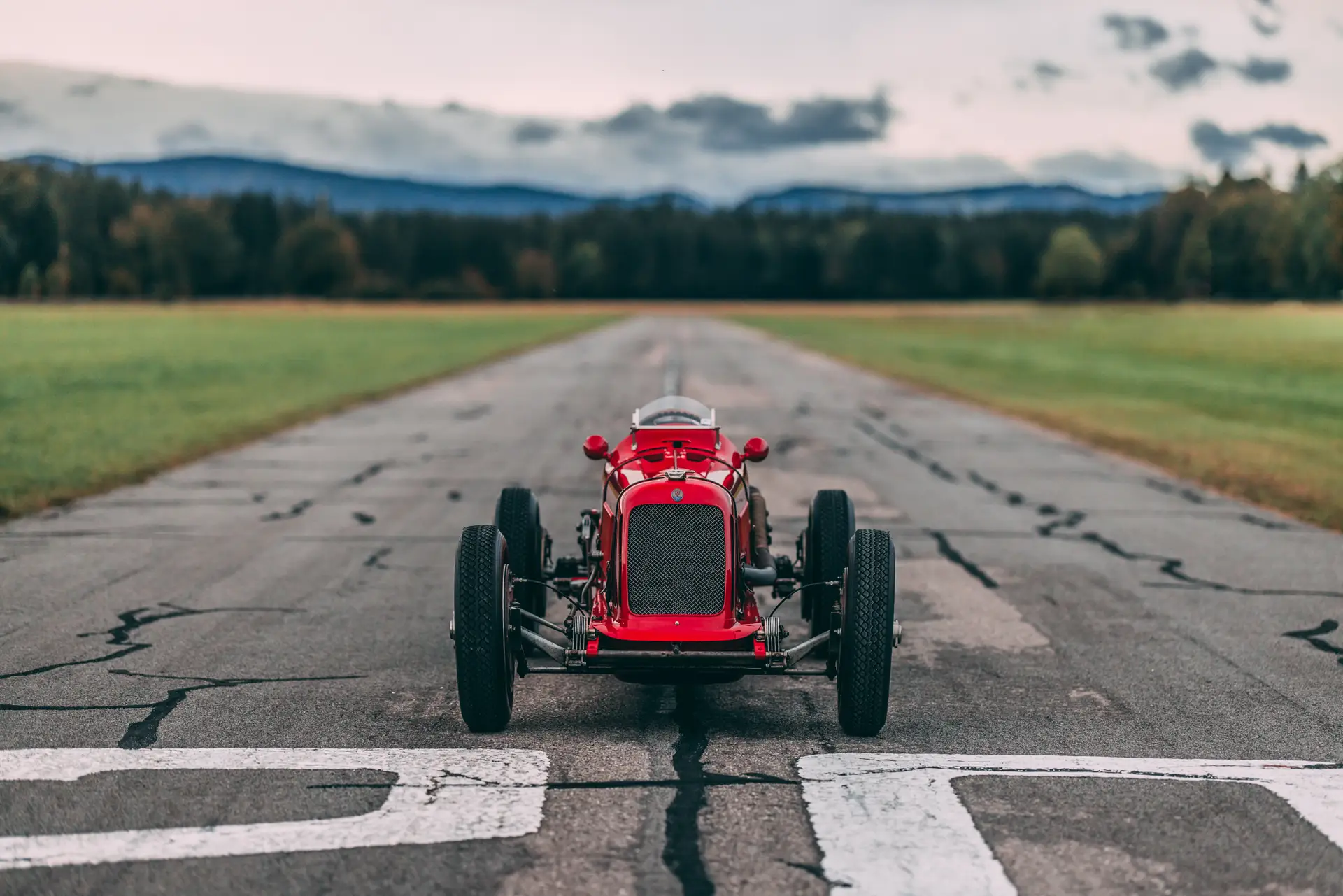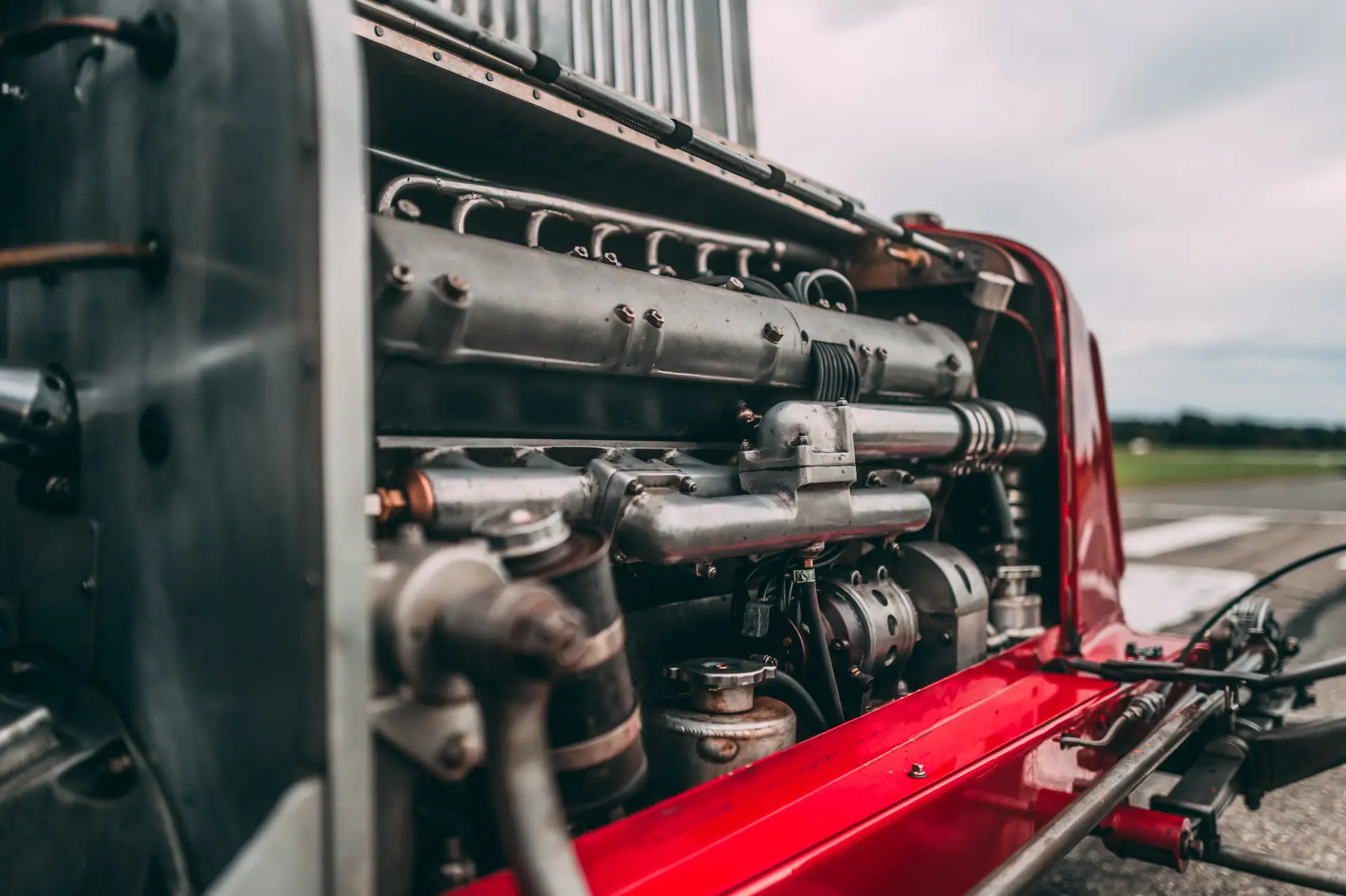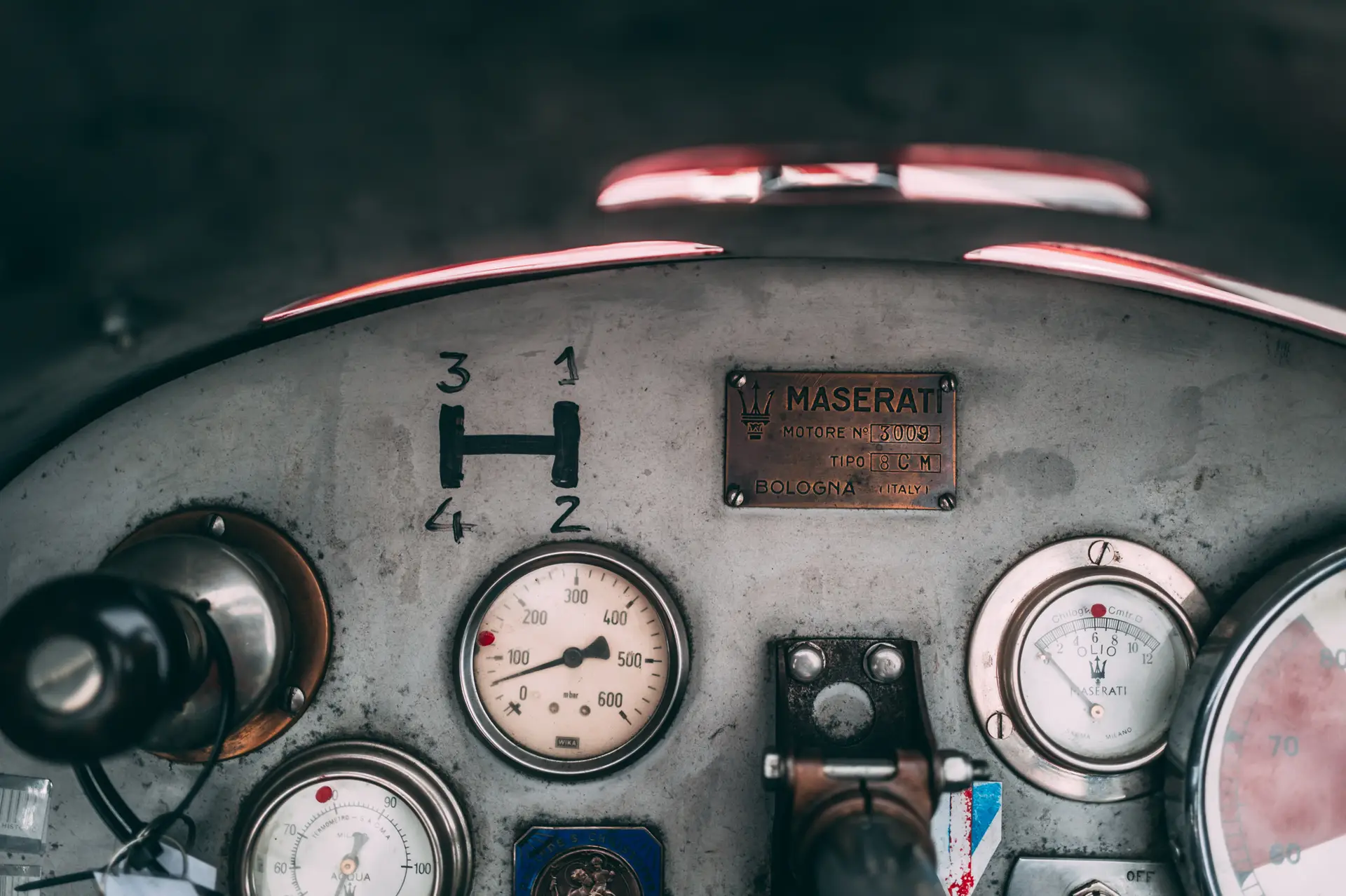

Maserati
8CM-3000
Key Facts:
- Matching-numbers engine, gearbox, rear axle and steering box
- FIA Technical Passport
- Eligible for some of the greatest historic racing events such as Goodwood, Monaco Historic Grand Prix and Monterey Motorsports Reunion
HISTORY
At the heart of the Maserati 8CM sits a 2,992 cc straight-eight engine. It is a comparatively simple design and had proven itself to be comparatively reliable, perfect for privateer entrants who sought dependable performance. By 1933 the engine officially produced 210 bhp at 5,600 rpm. Maserati initially built two cars with a two-seater body, designated 8C-3000, however all subsequent cars were to be built with monoposto bodies, hence 8CM-3000. The only weakness of the new design proved to be the handling, exacerbated by the new more powerful engine and a very narrow chassis (only 50 cm between the chassis rails). Some of the dynamic shortcomings were offset by the introduction of hydraulic brakes which remarkably had not been seen on a grand prix circuit since 1921! The inaugural 1933 season proved successful for the new Maserati monoposto, with famed drivers such as Nuvolari, Taruffi, Straight, Etancelin, Sommer, and Zehender, to name but a few bringing victories to the Modenese marque. Benoit Falchetto and ‘Gigi’ Soffietti also appear, with two victories for Falchetto in 1934 and a 3rd place in Algiers for Soffietti. Both drivers are significant in the history of chassis 3009. With four major grand prix victories, 1933 was one of Maserati’s most successful seasons in its history. In retrospect, 1933 was somewhat of a high-water mark for their Formula 1 success, due in part to the new 8CM-3000, whilst Scuderia Ferrari had be hamstrung by the less powerful Alfa Romeo Monza. Nuvolari’s switch to Maserati capped of the ideal circumstances. 1934 would be a different story, renewed competition from Alfa Romeo and the arrival of Mercedes-Benz and Auto-Union would dramatically change the competitive balance.
our 8CM-3000
The new regulations for 1934 required that Maserati widen the 8CM chassis. In addition, radius rods were added to the front springs and a power increase was promised, bring output to a claimed 230 bhp. The Maserati brothers received a large number of orders and refused sales to private owners to prioritise team orders. In January 1934 Countess Nelly Braillard, owner and manager of the eponymous Team Braillard of Paris ordered two new Maserati 8CM’s, the first to be delivered was chassis 3009, followed by 3015. The arrival of these two new cars for the team was heralded with great anticipation in the March 1934 edition of Motor Sport just as the 1934 was about to commence. Nelly’s brother, Louis Braillard, had already demonstrated considerable promise as a privateer driver behind the wheel of a Bugatti Type 35C and Type 51 during the early 1930s. It is believed that he was the first to drive ‘3009’ at the famed La Turbie Hill Climb in Provence, where he finished in 3rd place behind, Juan Zanelli and Count Carlo Felice Trossi. For much of the 1934 season ‘3009’ was driven by Team Braillard’s two drivers, either Benoit Falchetto or Louis Braillard. Falchetto was half French, half Italian, and had fought in World War I as a fighter pilot in the Italian Airforce. It was in the hands of Falchetto that ‘3009’ scored its most notable period victory with first place at the Monthlery French Grand Prix in September 1934. Throughout the 1934 season Team Braillard systematically entered the two identical cars and therefore identify the specific chassis number in each race remains challenging but the season was an overall success and ‘3009’ was present throughout. Louis Braillard retired from competition in the summer of 1934 and for the remainder of the 1934 season and into 1935 was replaced by Robert Brunet. 1934 Season: Date Grand Prix Track Entry No. & Driver Car Result 27th May Picardie Péronne Ecurie Braillard #18 Falchetto 8CM-3000 1st 3rd June Montreux Montreux Ecurie Braillard #20 Falchetto 8CM-3000 R 17th June Penya Rhin Montjuich Park Ecurie Braillard #22 Falchetto (3009)[1] #14/18 de Paulo (3015) 8CM-3000 R DNS 15th July Vichy Vichy Ecurie Braillard #30 Falchetto (3009)[2]or (3015)[3] 8CM-3000 R 22nd July Albi Albi Ecurie Braillard #30 Falchetto #18 Braillard 8CM-3000 R R 26th Aug X Grand Prix du Comminges St Gaudens Ecurie Braillard #12 Falchetto (3009)[4] #14 Scaron (3015) 8CM-3000 4 DNS 9th Sept I Grand Prix de l’UMF Montlhéry Ecurie Braillard #11 Sommer #12 Falchetto[5] 8CM-3000 DNS 1 23 Sept Spanish Lasarte Ecurie Braillard #26 Falchetto (3009)[6] #24 Brunet (3015) 8CM-3000 R R At some point in 1935 Team Braillard was disbanded. The team entered two 8CM’s (presumably 3009 and 3015) in Pau in February, and again May at the Picardie Grand Prix. However, for the remainder of the season only one car entered under the Braillard banner with Brunet and Falchetto never appearing alongside each other. Looking at entries for the post-July 1935 entries it would appear that Falchetto is without a car, suggesting that ‘3009’ was primarily his car and that it is around this moment that 3009 returned to its native Italy where it was driven by Gigi Solfetti of Turin for the remainder of the 1935 season. 1935 Season: Date Grand Prix Track Entry No. & Driver Car Result 24th Feb Pau Grand Prix Pau Ecurie Braillard #26 Falchetto #2 Brunet 8CM-3000 4 5 5th May Tunisian Grand Prix Carthage Ecurie Braillard #22 Brunet 8CM-3000 26th May Pircardie Grand Prix Peronne Ecurie Braillard #20 Falchetto #4 Brunet 8CM-3000 R R ~ The Picardie Grand Prix is the last occasion two 8CM’s enter under Team Braillard ~ 9th June Biella Biella #28 Soffietti 8CM-3000 R 30th June Penya Rhin Grand Prix Barcelona #20 Soffietti 8CM-3000 6 7th July Grand Prix de la Marne Reims #16 Soffietti 8CM-3000 R 4th Aug Coppa Ciano Livorno #18 Soffietti 8CM-3000 9 15th Aug Coppa Acerbo Pescara #33 Soffietti 8CM-3000 R 18th Aug Nice Grand Prix Nice #18 Soffietti 8CM-3000 6 Solfietti must have driven a third 8CM early in the season and then presumably made a switch to ‘3009’ for the second portion of the calendar. Solfetti campaigned the car again in 1936 but entered only one international event in Tripoli on the 10th May. In 1937 the car passed to a third pre-war owner, team Scuderia Saubada, who ran the car for Eduardo Teagno. By 1937 chassis 3009 had three highly competitive seasons under its belt, and the intervening years saw the Maserati largely outclassed. Nevertheless, Teagno was still able to produce one more finish for 3009 at the Swiss Grand Prix in Bremgarten in August 1938 and with remarkable bravery entered the German Grand Prix in July 1937 where the then four-year-old Maserati shared a grid with five of the latest Mercedes-Benz W125 and five Auto-Union V16’s! 1937 & 1938 Seasons Date Grand Prix Track Entry No. & Driver Car Result 25th July 37 X Grosser Preis Deutschland Nurbergring Scuderia Sabauda #36 Edouardo Teagno 8CM-3000 R 22nd Aug 37 IV Grosser Preis Schweiz Bremgarten Scuderia Sabauda #28 Edouardo Teagno 8CM-3000 DNS 7th Aug 38 Coppa Ciano Livorno Scuderia Sabauda #60 Edouardo Teagno 8CM-3000 R 21 Aug 38 V Grosser Preis Schweiz Bremgarten Scuderia Sabauda #26 Edouardo Teagno 8CM-3000 14 With the clouds of war again gathering over Europe ‘3009’ momentarily disappears from public view and is not recorded again until it emerges in the mid-1960s in a very poor condition and heavily modified. The car passes through the hands of noted Maserati collector and dealer Serge Pozzoli in Paris to a Mr Jones. The non-original parts, including a replacement body, were removed and the car dismantled pending restoration. In 1973 the project was acquired by noted Maserati expert, collector and author, Joel Finn, before briefly passing via a Mr Sutherland to noted marque specialist Sean Danaher. A painstaking restoration was commenced which was completed in the early 2000s. As many original parts as possible were saved and others were identified and reunited with the car. Today the car retains its original engine, gearbox and rear axle and steering box. With the restoration complete Sean Danaher rightly chose to return the car to competition, with successful outings at many of Europe’s best motoring events. Including three Goodwood Revivals, a class win at Goodwood Festival of Speed and won ‘Driver of the Day’ at the Nürburgring Oldtimer Grand Prix in August 2014. The car has been a regular and successful stalwart of HGPCA and VSCC races and has competed with the Midland Automobile Club at Shelsley Walsh (UK), taken part in the Vernasca Silver Flag Historic Hillclimb (Italy) and the Vintage Revival Montlhéry (France). In around 2015 the car passed to a second owner, Paul-Emile Bessade, who continued to race the car at events across Europe including further outings at Goodwood Member’s Meeting, Revival and at Montlhéry. Most recently chassis 3009 has been maintained and run by noted specialist Blakeney Motorsport of Hertfordshire. The car is offered with FIA Technical Passport and is eligible for many of the greatest historic racing events in the world, including Goodwood, Monaco Historic Grand Prix and the Monterey Motorsports Reunion. [1] https://www.goldenera.fi/gp3404.htm#18 [2] https://www.goldenera.fi/gp3406.htm#22 [3] Anthony Pritchard, Maserati: A History (London: David & Charles). page. 58 [4] https://www.goldenera.fi/gp3409.htm#33 [5] Uncertainty reigns about the identity of this winner – see Anthony Pritchard, Maserati: A History (London: David & Charles). page. 65 [6] https://www.goldenera.fi/gp3410.htm#37













